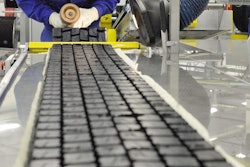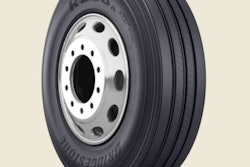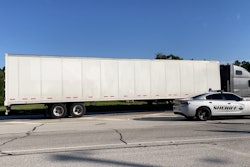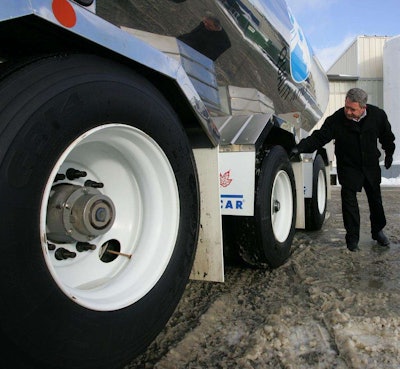
And, like fuel, drivers have a lot of say-so in the life – or untimely premature death – of a tire.
The first step in extending the life of your rubber starts with making sure you spec the right tire for your application.
Brian Buckham, general manager, product marketing for Goodyear, recommends fleets consult with their local tire dealer and ask them to make appropriate recommendations based on vehicle usage and tire performance characteristics such as fuel economy, durability, traction, miles to removal, casing retreadability, safety and price.
“This is the single most effective practice that a fleet can employ during the tire selection process,” he adds.
It’s also a good idea to seek first-hand experience when shopping around.
“Checking with a local dealer or non-competing fleets for best practices can shorten the learning curve substantially,” says Matt Loos, director, truck and bus marketing for Bridgestone Americas Tire Operations.
Leaning on the advice of others can also help keep you from making decisions based solely on upfront costs.
“Just because you pay more for a tire doesn’t mean you will get higher mileage and more retreads,” says Gary Schroeder, director of commercial vehicle and OEM sales for Cooper’s Roadmaster brand. “Conversely, upfront savings due to a lower price might not save you money in the long run.”
As fleets have put extra effort and training into getting more from their tires, manufacturers have tried to do their part by upgrading rubber compounds and targeting specific users.
“Over the years, tread compounds used in commercial truck tires have become increasingly application specific,” Schroeder says. “Rather than use just a couple tread compounds that cover an entire product range, which was fairly typical in the industry at one point, improvements in technology mean that most major brands now have treads tuned to excel in specific areas while maintaining acceptable performance across all other parameters.”
Paul Crehan, director of product marketing, Michelin Truck Tires, adds tire design has come a long way in the last 10-plus years.
“Compounds, casing design and tread sculpture provide a complete package toward achieving performance gains and work synergistically,” he says.
“Over the past 10 years there has been significant development and research into compounds that generate less heat build-up [in over-the-road tires], which inherently leads to less severe heat history in the tire and more retreadability,” says Dr. Prosser Carnegie, head of brand management, Commercial Vehicle Tires for Continental Tire the Americas “This is also directly related to the push for more fuel efficiency in commercial truck tires. Lower heat-build up compounds in general will aid in fuel efficiency of the tire and the retreadability.”
Once you’re sure the right tires have been mounted, the challenge becomes properly maintaining them. Improper inflation and poor rotation are the two primary causes of irregular tire wear and are among the easiest to avoid.
“Tire rotation should be part of your maintenance program,” says Homer Hogg, manager of technical development for TA/Petro, “but understanding how and when to rotate will depend on your specific operation.”
Important to consider in your rotation schedule is that tires on the same axle should always have a similar amount of tread depth.
“The mismatching of dual tire diameters will result in one tire carrying more individual tire load than the other,” Buckham says. “This also can occur when one tire is operated at a different air pressure than the other. In both cases, mismatching can lead to an adverse impact on optimized tire footprints, irregular wear and reduced tire life.”
Hogg says the life of both tires will be substantially reduced if dual tires are not within a quarter inch diameter of each other. When you have dual tires and one is larger in diameter than the other – but still within the quarter inch requirement – Hogg recommends the larger tire always be placed on the outside position.
Once you get your arms around a rotation routine, there’s plenty of help available for monitoring inflation.
“Modern (Tire Pressure Monitoring Systems) looks at heat and pressure, which should provide early detection for the operator to identify a tire defect before it becomes catastrophic,” Hogg says.
Under-inflated tires build up excessive heat due to over-deflection, which could deteriorate or damage the tire.
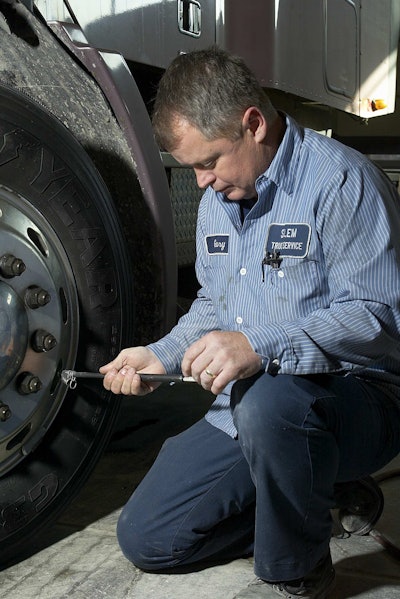
A study by Michelin revealed that a 15 percent over- or underinflation can reduce a tire’s lifespan by 10 percent. Research from ATA’s Technology & Maintenance Council has shown underinflation by just 10 percent – less than 11 PSI on a 105 PSI tire – can result in a fuel economy drop of 1.5 percent.
“Nearly half of all emergency service road calls are tire related, and underinflation – along with excessive heat, which is an additional consequence of low tire pressure – are responsible for 90 percent of tire failures,” Intagliata says.
“TPMS is a valuable tool in extending tire life, but should be used in conjunction with manual inspections, not as a substitute,” Loos adds.
A best practice for using TPMS, according to Jon Morrison, president of WABCO Americas, is to use the monitoring system to its full capability – from installation, to reviewing and responding to tire pressure system reports, and taking action to maintain proper tire pressure levels.
If your rotation and inflation are both in check, there is at least one overlooked aspect of extending tire life that often goes undetected. Worn wheel ends can strip tire tread by the 32nds and often disguises itself as something more familiar.
“Irregular wear is sometimes misdiagnosed as an alignment issue,” says Rick Martin, Meritor’s senior aftermarket training manager. “If they see tire wear on a trailer axle or steer axle, they’ll usually just take it and have it aligned.”
Martin adds you want the tires to be going as straight down the road as possible, as parallel to the road as possible, and no amount of alignment is going to fix a problem caused by a worn wheel end.
“You’re going to end up with some feathering,” Jim LeClaire, national OEM sales manager, Webb Wheel Products, says of running a tire with a worn wheel end. “The tire is going to end up squirming going down the road.”
Note: This is part one of a two part series. Part two, which will focus on retreads, will publish next month.



